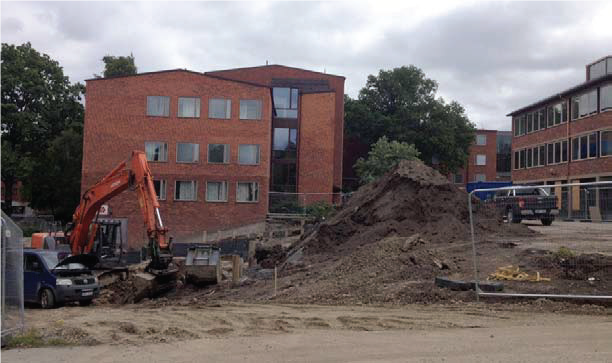KTH contributes to rock-solid constructions in Sweden and the EU

Within the EU there is a common set of standards, regulating how to build and verify the safety of structures, to facilitate for companies in the construction industry and to contribute to the harmonization of safety assessments between countries. There is now ongoing work on developing the part that concerns geotechnical engineering structures, Eurocode 7, and preparing the implementation for Swedish conditions. Johan Spross, a researcher at the Division of Soil and Rock Mechanics, takes part in the work representing KTH.

Since the 1970s there has been ongoing work for common safety standards for buildings and other structures - the Eurocodes - within the EU. The first version was ready in 2005 and it was implemented in Sweden in 2011. The fact that a European standard to be implemented after so many years of work was a success, but there were also shortcomings.
“Those who initially developed the standard focused on steel and concrete structures, and the same methods were expected to be used in other areas”, says Johan Spross. “It works fine when you build on top of soil but not as well for constructions within a rock mass, and things like tunnels and dams were also missing. Now we are working on adapting Eurocode 7, which is about geotechnical constructions, for Swedish conditions.”
Proposals on draft circulations and Nordic collaboration
Johan Spross researches the safety of geotechnical engineering structures, e.g. tunnels, shafts, and road and railway embankments. In his area, the Swedish National Board of Housing, Building and Planning (Boverket) chose to keep the existing regulations for rock that were used before the first European standard. The goal of the new revision is to entirely shift to the new European standard but also to review the regulations for construction on soil.
“The new code is produced by an independent European standardization committee where the Swedish Institute for Standards, SIS, is responsible in Sweden for proposals on draft circulations. I and professor emeritus Håkan Stille have assisted SIS in answering draft proposals from the European level to make Eurocodes better for Swedish conditions”, says Johan Spross. “When constructing on soil and rock the building material is given by nature, which demands both understanding and safety margins. In Sweden, the tradition is that a geotechnical engineer decides the amount of geotechnical investigation needed. In other countries, the tradition is to have more detailed regulation about this in the standard. This is one thing where we don’t agree between the European countries.”
The Nordic countries collaborate in mirror groups to be able to speak with a common voice when working with the new standard. The final compromise will be implemented in Boverket’s building regulations, if approved by the different standardization institutes as planned, in Sweden by SIS’s technical committee for geotechnics. A vote will be held in 2024.
A non-profit association facilitates the industry’s adaptation
The new standard will mean some changes when working with dimensioning and verification, making sure that the calculations are correct. Two years ago the non-profit association IEG 2.0 was formed, to facilitate for the industry in Sweden to adapt and be prepared when the new standard is launched in 2025.
“The association gathers agencies like the Swedish Transport Administration and the Swedish Transport Agency as well as companies within the geotechnical construction sector”, explains Johan Spross. “I am on the board representing academia. Together with the other members, we are working for a well-functioning and straightforward application of the new standard.”
IEG 2.0 has several steering and reference groups that cover all parts where the new code will lead to changes. With the help of inquiries and harmonization with other regulations, the goal is to produce an application document adapted to the Swedish tradition of working with safety and our geological conditions.
“For KTH it is important to collaborate in a work like this since we understand the underlying theory for calculations about constructions and safety. And we learn where the industry has problems and where more research on a theoretical level is needed. There are also good opportunities for getting funding for this kind of research and in addition to this, KTH can contribute with course development, for life-long learning in the industry.”
Continuous work with improvements and harmonization
One goal of the harmonization work is fair competition between companies in Europe, and also in Sweden. A more open market should improve the competition and counterbalance a local lack of engineers. This is favourable not least in Sweden since we don’t have enough geotechnical engineers. Instead, we have been able to take advantage of specialists from countries like Spain, where there were many experts but few jobs after the crisis in 2008.
“The new code aims at simplification, harmonization and development, for example, better methods for probabilistic design. We will hopefully see continuous development and revision in the future as well, I for example believe that we will be able to use artificial intelligence for safety assessments in the future. But the next area will be underground excavation, that is tunnels, which isn’t fully included in the new version.
Collaboration with the Technical University of Munich
In addition to working with the regulatory framework, Johan Spross has several international engagements. He has a seat in a working group on probabilistic design at the European level and he has been a guest researcher at the Technical University of Munich, TUM. Before the pandemic, he had planned to spend four more months with a group that works with assessment and understanding of risk at TUM. Those plans had to be postponed but they can hopefully become reality soon.
Text: Johan C Thorburn
This is the 30th article in the
